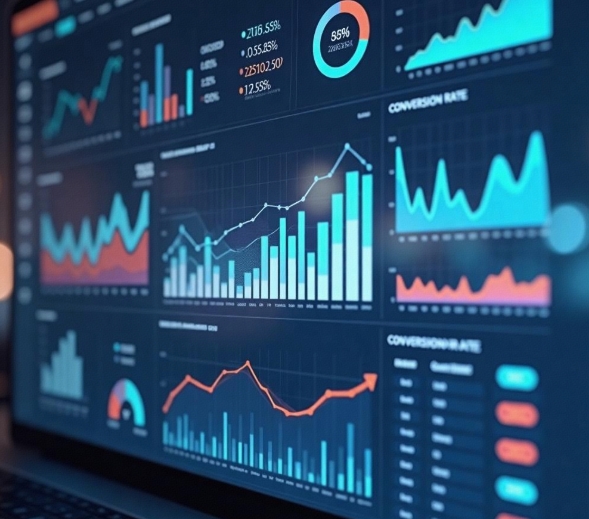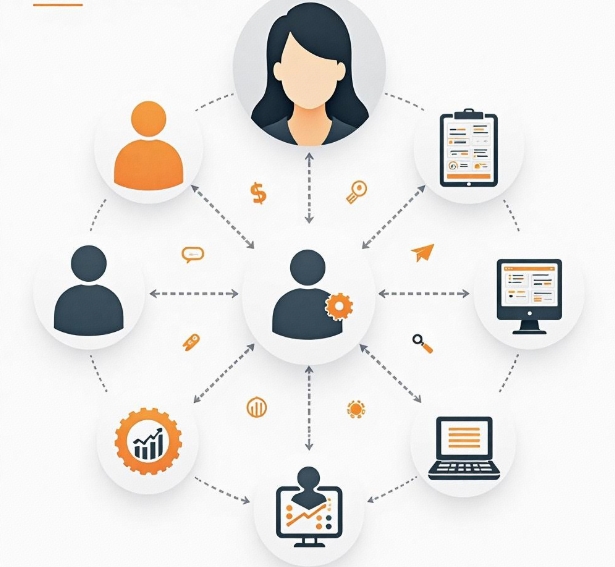Data Analysis and User Behavior Tracking in E-commerce Platform Development
- latest articles
- 1.DApp Development & Customization: Merging Diverse Market Needs with User Experience 2.Analysis of the Core Technical System in DApp Project Development 3.How to achieve cross-chain interoperability in Web3 projects? 4.How does the tokenization of points reconstruct the e-commerce ecosystem? 5.How to Set and Track Data Metrics for a Points Mall? 6.What is DApp Development? Core Concepts and Technical Analysis 7.Inventory of commonly used Web3 development tools and usage tips 8.Development of a Distribution System Integrated with Social E-commerce 9.Six Key Steps for Businesses to Build a Points Mall System 10.What is DApp Development? A Comprehensive Guide from Concept to Implementation
- Popular Articles
- 1.Future Trends and Technology Predictions for APP Development in 2025 2.Analysis of the DeFi Ecosystem: How Developers Can Participate in Decentralized Finance Innovation 3.From Zero to One: How PI Mall Revolutionizes the Traditional E-commerce Model 4.DAPP Development | Best Practices for Professional Customization and Rapid Launch 5.Recommended by the Web3 developer community: the most noteworthy forums and resources 6.From Cloud Computing to Computing Power Leasing: Building a Flexible and Scalable Computing Resource Platform 7.How to Develop a Successful Douyin Mini Program: Technical Architecture and Best Practices 8.Shared Bike System APP: The Convenient Choice in the Era of Smart Travel 9.How to Create a Successful Dating App: From Needs Analysis to User Experience Design 10.From Design to Development: The Complete Process of Bringing an APP Idea to Life
In the context of the rapid development of modern e-commerce, the development of online stores relies not only on product variety and quality but also on factors such as website interface design, streamlined shopping processes, and payment convenience. However, the success of store development is not solely determined by the user shopping experience; it is also closely related to the effectiveness of data analysis and user behavior tracking. Through in-depth analysis of user behavior, store development teams can gain substantial business intelligence, enabling them to make more targeted decisions in areas such as product optimization, marketing, and customer service. This article will explore how data analysis and user behavior tracking can enhance user experience, optimize operational strategies, and promote the sustainable development of online stores during the development process.
I. Basic Concepts of Data Analysis and User Behavior Tracking
1. Data Analysis
Data analysis involves organizing, statistically analyzing, and interpreting collected data to derive meaningful insights and provide a basis for decision-making. In store development, the primary role of data analysis is to process various types of information, such as user visit data, transaction data, and purchasing behavior, to identify underlying patterns. This helps store managers formulate more precise marketing strategies, improve user satisfaction, and ultimately increase store profitability.
2. User Behavior Tracking
User behavior tracking involves using a series of technical methods to collect and analyze user behavior data on the store platform in real-time. By monitoring user actions such as clicks, browsing, searches, adding items to the cart, and purchases, the store can gather information about user interests, preferences, and purchasing motivations. This behavioral data not only helps store managers understand user needs but also supports subsequent personalized recommendations and targeted marketing efforts.
II. Data Analysis Techniques in Store Development
In store development, data analysis techniques include data mining, machine learning, and artificial intelligence. With continuous technological advancements, data analysis techniques are also evolving and upgrading. Here are several common data analysis methods:
1. Data Mining
Data mining is the process of extracting potential patterns, rules, and knowledge from large datasets. In store development, data mining can help developers identify consumer purchasing habits, product associations, and other insights. For example, by analyzing user purchase records, a store can discover products that are frequently bought together and use this information for related product recommendations or promotions.
2. Machine Learning
Machine learning involves using algorithms to enable computers to learn automatically from data and make predictions. In store development, machine learning is often applied to user behavior prediction and personalized recommendations. For instance, by learning from historical user behavior data, machine learning models can predict products a user is likely to purchase in the future, thereby providing more accurate product recommendations.
3. Artificial Intelligence
Artificial intelligence (AI) technology is increasingly being applied in store development. AI can intelligently adjust store content, layout, and recommendation systems through in-depth analysis of user behavior data, enhancing the shopping experience. Additionally, AI can improve the intelligence of customer service systems using natural language processing, enabling users to receive faster and more accurate assistance through interactions with AI-powered customer service.
III. Technical Methods for User Behavior Tracking
1. Website Analytics Tools
Many store developers use professional website analytics tools, such as Google Analytics and Baidu Statistics, to track and analyze user behavior on their websites. These tools allow developers to view metrics like user visit paths, dwell time, and bounce rates, helping them understand which pages attract users and which ones have issues, thereby optimizing page design and user experience.
2. Heatmap Analysis
Heatmaps are data visualization tools that use color variations to display user behavior. In store development, heatmaps help developers identify click hotspots and mouse movement trajectories on pages. This is crucial for page layout and design. By analyzing heatmaps, developers can determine which areas attract user attention and which areas may be overlooked, enabling targeted page optimizations.
3. User Behavior Tracking Tools
In addition to common analytics tools, many stores utilize specialized user behavior tracking tools like Mixpanel and Hotjar. These tools precisely record every user action on the store, including clicks, scrolling, and mouse hover positions. Through in-depth analysis of this data, stores can better understand user needs and improve product design and user experience.
IV. Applications of Data Analysis and User Behavior Tracking in Store Development
1. Optimizing User Experience
User experience (UX) is a key factor in the success of an online store. Through data analysis and behavior tracking, developers can accurately understand user operational habits and identify obstacles encountered during usage. For example, if analytics data show a high bounce rate at a specific step in the shopping process, developers can investigate further to determine if the issue is due to slow page loading, unintuitive interface design, or problems with the payment process. By optimizing these details, the store can significantly improve user retention and conversion rates.
2. Personalized Recommendations
Personalized recommendation systems are commonly used in modern e-commerce platforms to enhance user experience and increase sales. By analyzing user behavior, stores can tailor product recommendations to individual users. For instance, based on browsing history, purchase records, and search keywords, a store can recommend related or similar products. Data analysis and behavior tracking enable stores to more accurately identify user interests, providing more precise recommendations that boost purchasing intent and platform conversion rates.
3. Enhancing Marketing Effectiveness
By analyzing user data, stores can better understand which marketing activities are most appealing to users and which ads or promotions yield higher conversion rates. For example, stores can use A/B testing to evaluate the effectiveness of different ads, coupons, and promotional campaigns, allowing them to adjust marketing strategies accordingly. Through targeted marketing, stores can improve the ROI (Return on Investment) of ad placements and maximize marketing effectiveness.
4. Predicting User Needs
By analyzing users' historical purchasing behavior, store developers can predict future user needs. For instance, certain products may experience higher demand during specific seasons or holidays, allowing stores to prepare inventory in advance to avoid stockouts. Additionally, analyzing user search behavior can help stores anticipate market trends and adjust product offerings and promotional strategies in a timely manner.
V. Data Privacy Protection and Compliance
When conducting data analysis and user behavior tracking, data privacy protection is a critical consideration. Store developers must comply with relevant laws and regulations, such as the General Data Protection Regulation (GDPR), to ensure user privacy is not leaked or misused. Stores must clearly inform users about what data will be collected and obtain their consent. Additionally, stores need to implement technical measures to protect user data security, such as encrypted storage and access control.
VI. Summary and Outlook
Data analysis and user behavior tracking play a crucial role in store development. By deeply analyzing user behavior and needs, store developers can optimize user experience, enhance personalized recommendations, execute precise marketing campaigns, and predict market trends. However, as data collection and usage increase, protecting user privacy and ensuring data security have become significant challenges that developers must address. In the future, with further technological advancements, data analysis and user behavior tracking will play an even more important role in the e-commerce industry, driving stores toward greater intelligence and personalization.
-

How does the tokenization of points reconstruct the e-commerce ecosystem?
With the continuous advancement of internet technology and the gradual prolifera···
-

How to Set and Track Data Metrics for a Points Mall?
With the rapid development of the e-commerce industry, points malls, as a common···
-

Development of a Distribution System Integrated with Social E-commerce
With the rapid development of internet technology, the e-commerce industry has e···

 Blockchain
Blockchain












